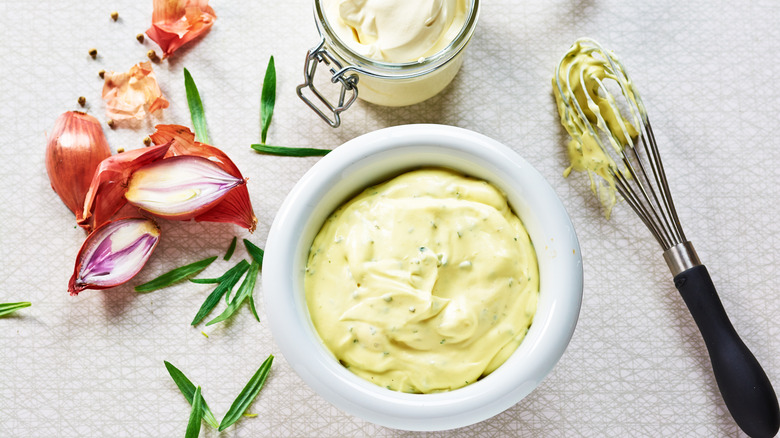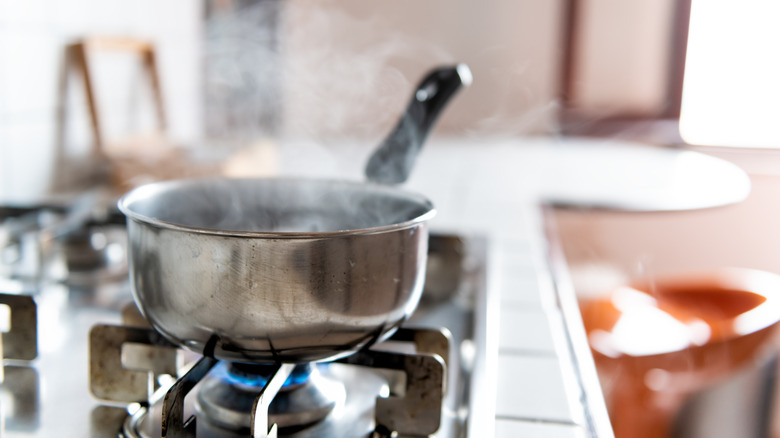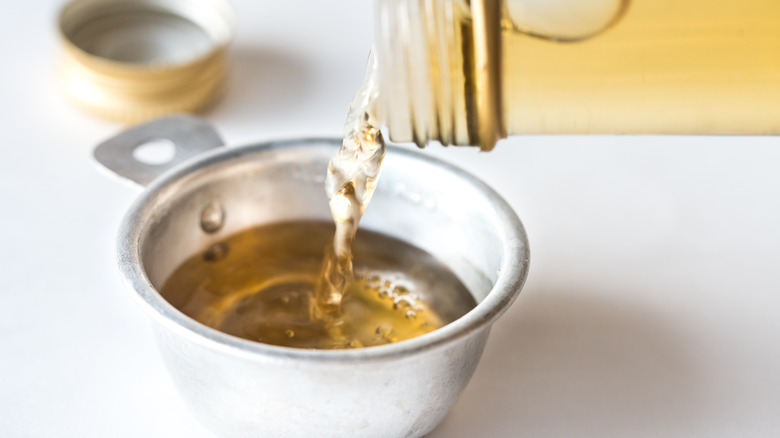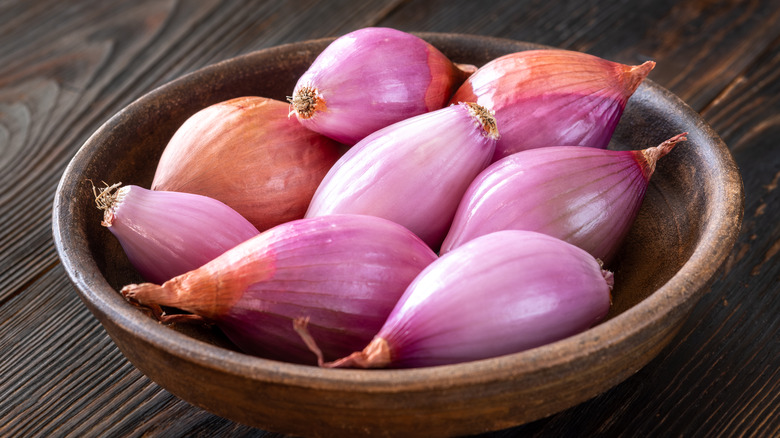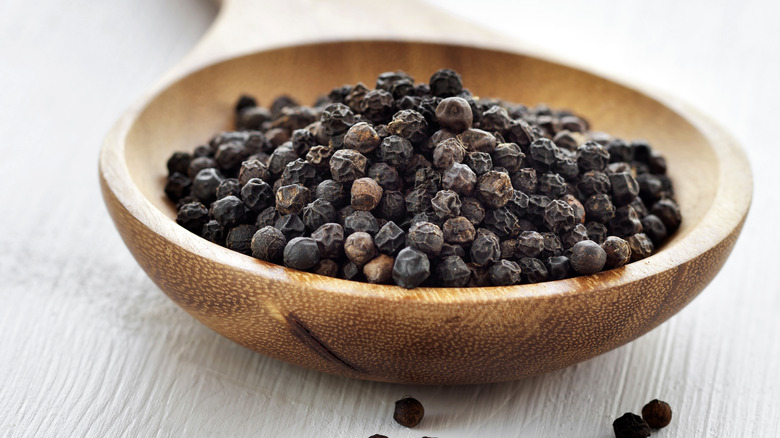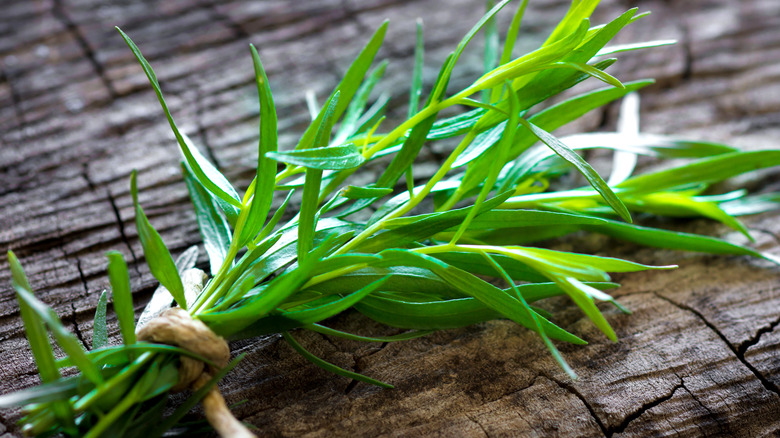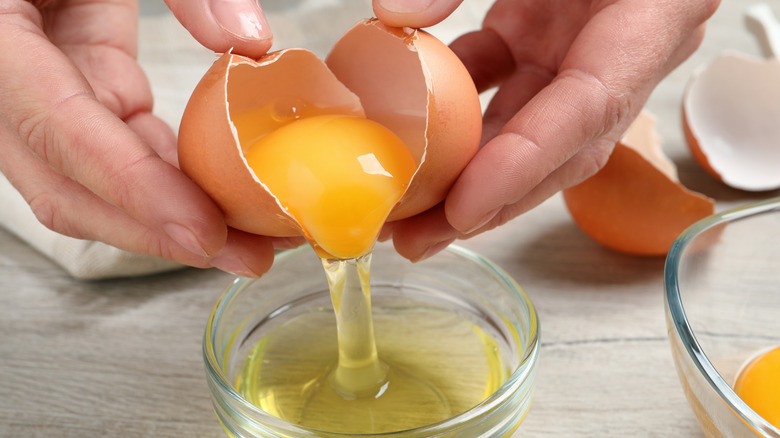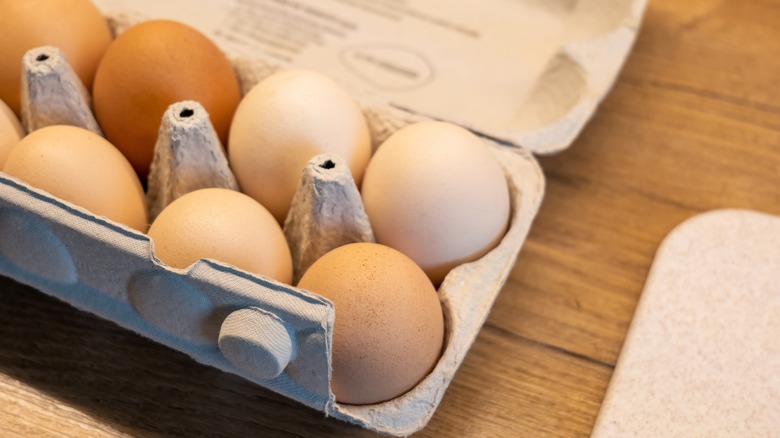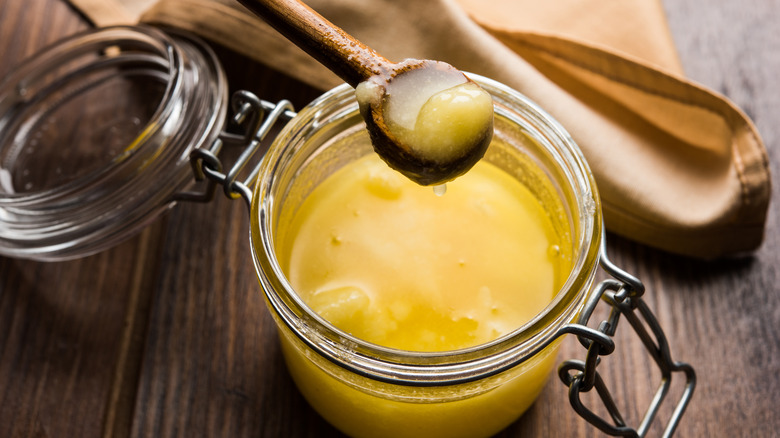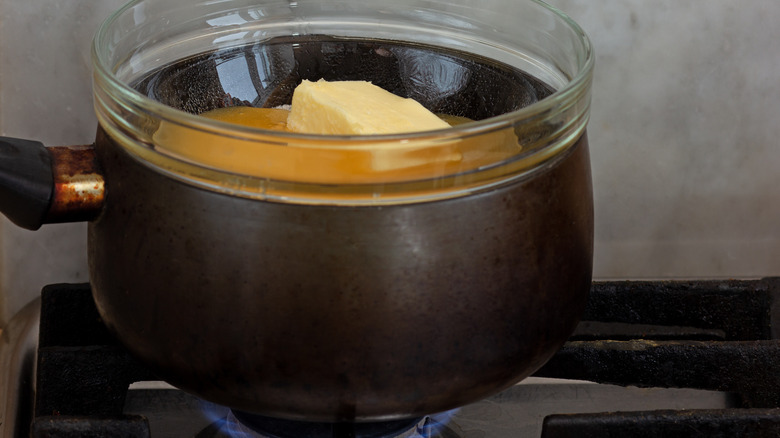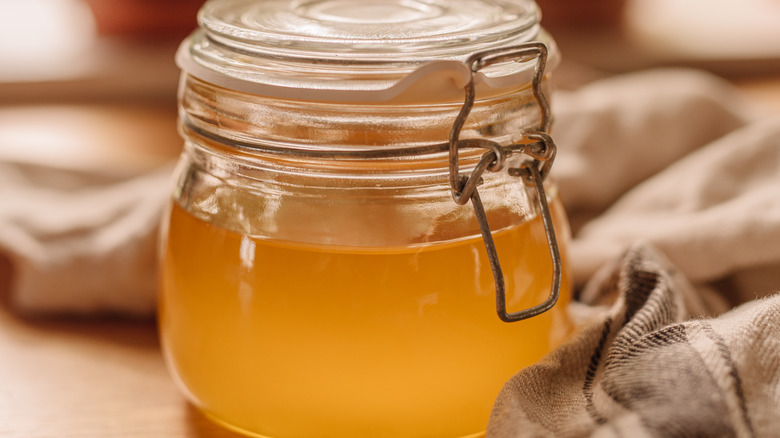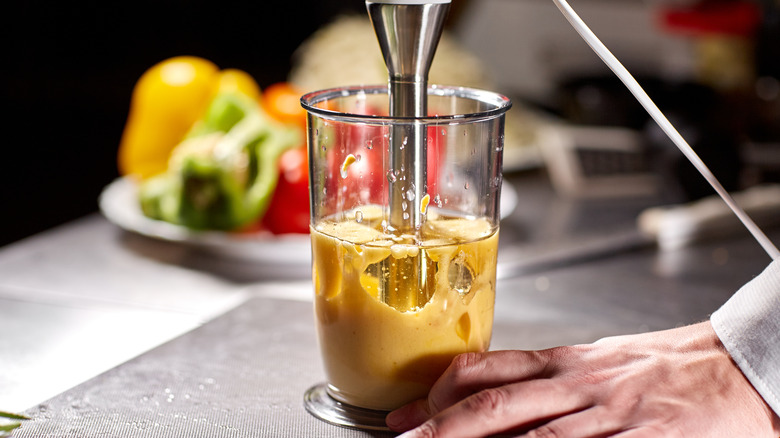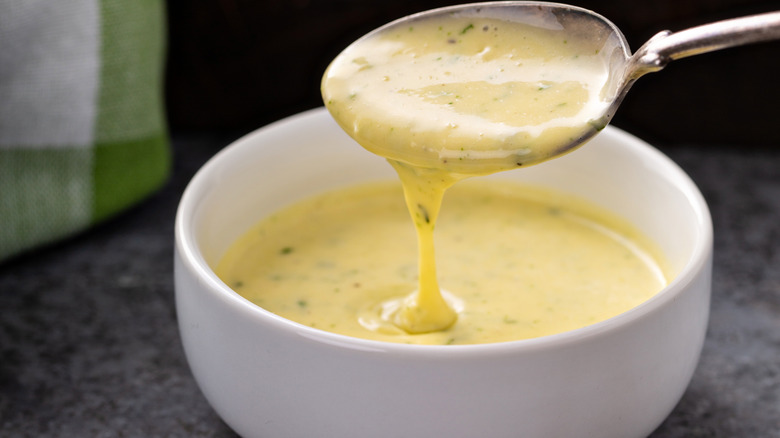12 Tips You Need To Make Perfect Bearnaise Sauce
One of the beloved staples of French cuisine is béarnaise sauce, a herbaceous, tangy, and buttery accompaniment that's often served with steak. It can also be served over grilled fish or vegetables, over poached eggs, in a steak sandwich, or used to dip your fries into. It's one of the classics, and it stems from hollandaise, one of the five French mother sauces, along with béchamel, espangole, tomato, and velouté.
While many of the mother sauces require a bit of know-how and sometimes a longer cooking time, béarnaise is an achievable yet impressive sauce that any home cook can master, without needing hours of cooking. Every French chef has a way of making a béarnaise sauce, and there are slight differences from person to person. The essential béarnaise sauce is a white wine vinegar-based shallot and tarragon reduction, thickened with egg yolks and emulsified with warm butter.
There are some key ingredients and tricks to make it the right way, and there are also some shortcuts that help you get the right outcome with consistency. Here are some of the best tips you need to keep in mind if you want to make the best béarnaise sauce, every time.
Start with a shallot reduction
A shallot reduction is at its heart an infused vinegar that has been boiled down until most of the liquid has evaporated, leaving behind a concentrated concoction. This flavorful mixture is what adds the bulk of the flavor and tang to béarnaise sauce, and cuts through the richness of the butter to create that moreish bite. This shallot reduction is the main component that differentiates hollandaise sauce from béarnaise, so it's safe to say this is one of the most important parts.
To make the shallot reduction, start with a saucepan filled with finely chopped shallots in white vinegar. Some recipes also call for white wine, but this is optional and won't affect your final sauce too much either way. You slowly heat that up, along with your herbs like tarragon, and black pepper. Keep the mixture at a steady simmer for as long as it takes to reduce the liquid to just about 3 tablespoons. Even less liquid (up to a tablespoon) is also acceptable as the flavor is all there in a condensed form.
This reduction needs to cool completely before moving on to the next step of adding egg yolks. It's then your preference whether to strain out the remaining liquid with a sieve or to use the lumpy mixture altogether, depending on whether you want a more refined or rustic béarnaise sauce to serve.
Opt for white wine vinegar
Using the wrong type of vinegar in your dish can drastically affect the level of acidity and sharpness, so having a basic understanding of different kinds of vinegar can greatly benefit your cooking. When it comes to béarnaise sauce, the vinegar that works best is white wine vinegar. White wine vinegar has a milder acidic taste with a more complex flavor than regular white vinegar, and if you're adding white wine to your shallot reduction, they'll work together well.
White wine vinegar is made from white wine that has been fermented into vinegar, therefore retaining the slightly fruity flavor of the wine. This makes it perfect for salad dressings and sauces like béarnaise, as it adds a mellow acidity and hint of grape flavor. The same applies to champagne or sherry vinegar, both of which are common substitutes for white wine vinegar and can also be used in béarnaise.
Since plain white vinegar has a neutral flavor, using it in béarnaise will result in a much sharper sauce without the added complimentary flavor. The same logic can be applied to red vinegar and red wine vinegar, so while it's best to use white wine vinegar in béarnaise sauce, you can get away with using red wine vinegar, too.
Stick to shallots instead of onions
Shallots and onions come from the same family allium family, along with garlic, chives, and leeks. Some people might use shallots and onions interchangeably, but they have different flavor profiles making onions more suitable for certain recipes and vice versa. Shallots are slightly smaller than onions and sometimes longer in shape than onions and can come in purple, bronze, and white hues.
All béarnaise recipes call for using shallots in the "shallot reduction" and there's a reason for that. Shallots have a milder and more delicate flavor than onions which have a spicier and more pungent bite that can overpower the reduction. That's why shallots are great in sauces, dressings, and vinaigrettes, either raw or cooked, because they infuse a mild sweetness into them without overwhelming the taste the way onions do. It might seem like an easy swap to do if you don't have shallots, but you'll notice a significant difference in taste if you do.
Freshly cracked black pepper has the best flavor
You'll be adding black pepper into your shallot reduction, and in order to get the best peppery flavor, you should use freshly cracked black pepper, rather than ground. Using ground pepper is one of the common ways that store-bought shortcuts are weakening your meals and that includes in a béarnaise sauce recipe. Ground pepper tends to lose spiciness over time as it's exposed to oxygen, so it makes it an option for food you're trying to mildly season when you don't want black pepper to be prominent.
Traditional béarnaise recipes call for "poivre mignonette," or coarse black pepper, because it's got the most potent flavor. The easiest way for anyone to crack black pepper with kitchen utensils you already own is to crack them with the bottom of a pan. Pour out a single layer of peppercorns onto your countertop or wooden board, then press down with a pan until you hear them crack. It's possible to use whole peppercorns, but cracking them will release more bite.
Fresh is best when it comes to herbs
When it comes to making an authentic and flavor-packed béarnaise sauce, using fresh herbs is the best option. Fresh herbs really make a difference to the taste and maximize the herbaceous backbone of the sauce. Especially since you add herbs in two different stages of béarnaise, first in the shallot reduction, and then add the end straight into the sauce. However, if you don't have fresh herbs or they're out of season and you can't find any at the store, you can still use dried herbs. While fresh herbs will result in a "herbier" taste, your béarnaise sauce will still taste good if you use dried.
The most important herb to use is tarragon, which is a non-negotiable. French chefs sometimes recommend adding the stems in the shallot reduction to boost the flavor even more, which is another reason why using fresh tarragon is preferable. People also commonly use chervil, another one of the four traditional fine herbs in French cooking (along with tarragon, chives, and parsley.)
Stick to egg yolks only
It's important to separate your egg yolks from their whites to have the most optimum result for this recipe. Egg yolks shine on their own in béarnaise sauce because yolks are full of fat and proteins that make the best emulsion while adding richness. Using whole eggs can have a number of unwanted consequences, like a sauce that's too foamy, watery, and not rich enough.
To emulsify a mixture is to temporarily form one stable mixture of two liquids that usually can't mix, like oil and water. So they're essentially forced to join by being suspended together through various means. This is what makes egg yolks the perfect ingredient for emulsification because they have proteins that both repel and attract water. When you mix the yolks with butter and water, some proteins in the yolks will join the fat and some will join the water, bringing together the two into one uniform silky liquid.
Let your eggs get to room temperature first
As with baking and any involvement of eggs in cooking, it's important to let your eggs get to room temperature before using them. If you're taking them out of the fridge, let them stand for a while before you add them to your sauce. When cold, eggs don't mix as easily and can be more difficult to work with. When using cold eggs and butter, it can cause the fat in the butter to harden, when we want the opposite. Although we're adding butter to a warm mixture in the case of béarnaise, it can affect the emulsification process, especially if you're using the blender method rather than taking time over a double boiler.
However, it's important to note that eggs separate more easily when cold, so it makes sense to separate the yolks from the whites straight out of the fridge and then let them sit at room temperature afterward. To get eggs to room temperature, let them stand for 30 minutes. However, if you're pressed for time, you can place the bowl of separated egg yolks in lukewarm water for 10 minutes.
For a richer taste, use clarified butter or ghee
Anyone who's had béarnaise sauce knows it's butter heaven. Its richness is what makes the sauce so satisfying, and while normal butter is perfectly sufficient to use when making it, many French chefs advise using clarified butter for its sophisticated taste to enhance the flavor of béarnaise.
Clarified butter, also known as ghee or samna, has been used for over a thousand years in South Asia and is also a staple in parts of the Middle East and Africa. It's a sort of concentrated butter, that has had the milk solids and water removed from it, leaving behind a golden, clear liquid with an intensely rich almost nutty taste.
How to clarify butter is not challenging and anybody can do it themselves. All it takes is bringing some unsalted butter to a light boil, skimming off the solids or foam that appear on top until no more foam forms or until the liquid separates from the solids completely and falls to the bottom. Then, carefully pour out the liquid through a cheesecloth strainer to remove any of the remaining milk solids. This golden caramelized liquid is clarified butter, and it can be kept for up to six months.
Try the double boiler method
The trickiest part of making béarnaise is when you start warming the egg mixture to create the emulsification process. This is the point where everything can go wrong and you can end up with a lumpy liquid of scrambled eggs, instead of a velvety sauce. Skilled chefs tend to use direct heat from the stovetop and keep it low while whisking the egg yolk, water, and reduction mixture. They often say you should be able to touch the bottom of the saucepan with your hand, and if it's too hot to touch, you have to remove the pot and turn down the heat.
Using a double boiler helps you to mitigate any risks of the pan getting too hot. Also known as a "bain maries" in French, a double boiler is the use of indirect heat to warm or cook something using the steam from a pot of boiling water. You can create your own by using two pots or a pot and a bowl. Fill the bottom pot with heat and place on medium heat on your stove. Add your egg yolk mixture to another container on top of that and whisk. This creates a more gentle heat that's better to use on more delicate recipes like this one.
The temperature of your butter matters
It's not just room-temperature eggs that make a better béarnaise sauce but the temperature of your butter can make or break béarnaise. Adding cold butter to your egg yolk mixture can interfere with the emulsion and cause it to split. Instead, using room-temperature butter is a more foolproof way to ensure success, and this is why most baking recipes also call for room-temperature butter.
Clarified butter tends to be liquid at room temperature (depending on the season) which also helps you to drizzle in your butter slowly. Take your time drizzling in the butter while you whisk because adding it in slowly enough will also prevent the sauce from breaking or separating. If you're using the blender method, you have to use warm butter, and adding in a little bit at a time helps to temper your eggs, the way you would when making a custard or creme anglaise. Tempering your eggs means that you add a tiny bit of warm liquid into your eggs to bring the mixture to a higher temperature at a rate that won't cook them before adding in the remaining liquid.
Emulsify the sauce with a blender
Ever since we found out we could make mayonnaise with a stick blender, it's become popular to use the same method to make hollandaise and béarnaise the same way. Instead of spending a long time furiously whisking eggs on low heat, making your arm tired, you can completely forego that step and the double boiler altogether. Now, you can use this blender trick for en extra creamy béarnaise sauce in seconds.
To use this method you need to warm up your butter because this is where your heat is going to be coming from that's going to cook the egg mixture. Then, add your cold vinegar reduction, egg yolks, and water into a tall container and insert a stick blender into it. You want your container to be just wide enough to fit the blender in order to create a strong enough force to cause emulsification. Then you start your blended while slowly adding in the warm butter. You'll watch it turn into a creamy silky sauce before your eyes.
If you don't have a stick blender, you can use a normal blender that allows you to drizzle in the butter from the top while it blends, and you'll have the same result.
Adjust thickness with water
An unlikely ingredient in this buttery concoction, but water is a central ingredient in making béarnaise sauce. You add water to your egg yolk and reduction mixture before you begin the emulsification process. It supports the yolks to emulsify and helps them not scramble as you add heat to them. Recipes might call for different measures of water, but the general rule is to add one tablespoon of water per yolk.
Water is also useful in thinning out your sauce if it becomes too thick. Because of the technicality of the emulsification process, people are hesitant to do anything to the sauce once it's thickened, but there's nothing wrong with adding some water to it, it won't split or alter the sauce in any way. Don't be tempted to reach for more vinegar because this will make your sauce way too sharp.
Water is also helpful if you're trying to reheat the sauce after it's cooled. This isn't recommended though as it's meant to be eaten immediately. However, if you have leftover sauce that you don't want to waste, you can warm it up on the stove and add some water to it, which will help it not to separate.
